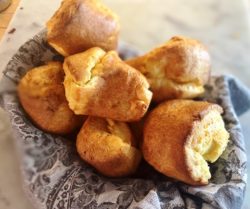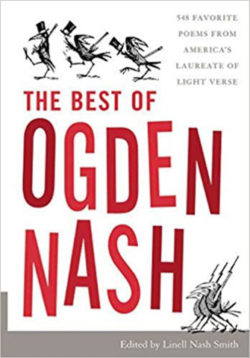Home cook (and baker and great food photographer) Howie contributed this pic of his terrific-looking popovers, above, to the AllRecipes! site. Yum. On the front, a popover photo courtesy of Chicago Metallic, manufacturer of, among many other things, popover pans.
After owning one of the best cooking stores in the US for 47 years—La Cuisine: the Cook’s Resource, in Alexandria, Virginia—Nancy Pollard now writes Kitchen Detail, a blog about food in all its aspects—recipes, film, books, travel, superior sources and food-related issues. She and her husband, the Resident Wine Maniac, have recently moved to Italy.
Ogden Nash on Popovers
Let’s call Yorkshire pudding
A fortunate blunder:
It’s a sort of popover
That turned and popped under
THIS FUNNY American riff on the British Yorkshire Pudding, which were also called Laplanders, first appeared in a domestic cookbook published in 1856. I have baked quite a few varieties, including some lamentable hockey pucks. My favorite version comes from a stained green brochure I have had for over 40 years, along with two wire-rimmed aluminized steel popover pans (see below), the kind we sold at La Cuisine before the bakeware company, Chicago Metallic, pursued the deadly Teflon route. They have now switched to a safer silicone-lined version. My daughters are looking to inherit one of my vintage pans each. There are some pretty good homey recipes on the tattered pages of my ancient brochure, but the one I am most afraid to lose is the popover recipe.
This particular technique, which includes the preheated pan with a bit of melted butter in each indentation, will give you a nice but not-too-thick crust and a yummy custardy interior, just like that proper pillow that is the stuff of our dreams. I grease the interior of each cup as well as the lip, as the batter balloons over while baking. The volume of each cup is a bit over ½ cup (120ml), and I put just over 1/3 cup (80ml) in each one. Straining the batter through a fine sieve makes for a poofier finish. Have your towel- or napkin-lined basket or tray ready, the butter and jam on the table and your hot drink brewed, as these lovely morsels wait for no man, woman or child.
Poofy Popovers

- 1 cup (120gr) white all-purpose flour
- 1 cup (237ml) whole milk
- 3 large or extra-large eggs
- ¼ teaspoon fine sea salt
- 1 tablespoon (14gr) unsalted butter, melted
- Additional 2 tablespoons (28gr) unsalted butter cut into 6 pieces
- Grease metal (not ceramic) cups or muffin pan (each should hold about 4 ounces) (113gr).
- Preheat oven to 425F and set a single rack in the middle. These popovers can rise high enough to hit the bottom of a second rack.
- Preheat the pan while blending the flour, milk, eggs, salt and melted butter. This can be done in a mixer, blender or food processor.
- Pull the pan out of the oven and add a piece of butter to each cup. Return the pan to the oven until the butter has melted and is just bubbly.
- Strain the batter before pouring some into each cup. Each should be at least half full.
- Put the pan back into the oven, andset a timer for a 20-minute bake.
- After 20 minutes, reduce the heat to 325F and bake for an additional 10 to 15 minutes. You can check after about 8 minutes if you feel the popovers are browning too quickly.
- Remove the pan from oven. Remove the popovers—you may have to take a paring knife to loosen them around the edges.
- Place the popovers in a cloth-lined basket, tray or bowl to serve.

 By the way, as a child, I loved reading, memorizing, and reciting the short poems and limericks of’ Ogden Nash. So you might want to give a book of them to your children or grandchildren for a different sort of fun when you want your cellphone back. In the meantime, they might also enjoy the results of this easy-peasy popover recipe.
By the way, as a child, I loved reading, memorizing, and reciting the short poems and limericks of’ Ogden Nash. So you might want to give a book of them to your children or grandchildren for a different sort of fun when you want your cellphone back. In the meantime, they might also enjoy the results of this easy-peasy popover recipe.



Hello Janet,
Yes, greasing each cup is important in addition to the sneaky pat of butter in the bottom of each. Every once in a while, maybe one will stick, but not much.
Thanks, Nancy. Next batch!
My husband made them tonight, and they were fabulous. One teeny quibble–they did stick a little to the tin. Any way to prevent that?
This is TON, The Other Nancy, not the one who cooks and bakes so well (but the one who tries). I assume you followed Nancy Pollard’s note to grease the popover pans? When I preheat the pans, I grease them then and leave a bit of lard at the bottom. If lard freaks you out, you can pretreat with cooking spray, then when you’re about to pour the batter in, add a half pat of butter to each mold. Of course, they’re good even if you have to scrape them onto your bread plate!
Thanks, TON. I’ll pass on the information to the popover maven in the family.